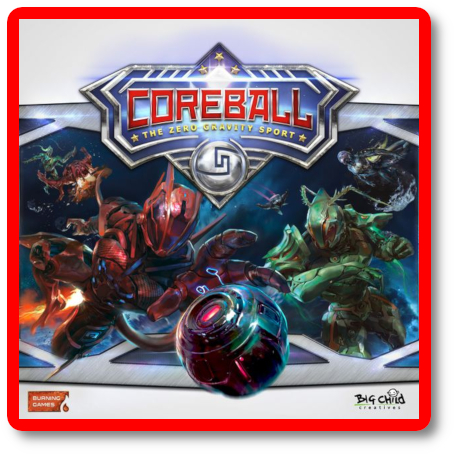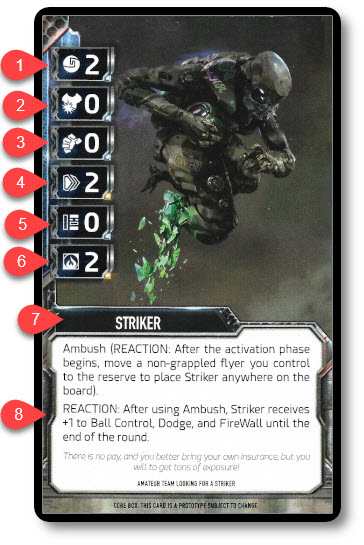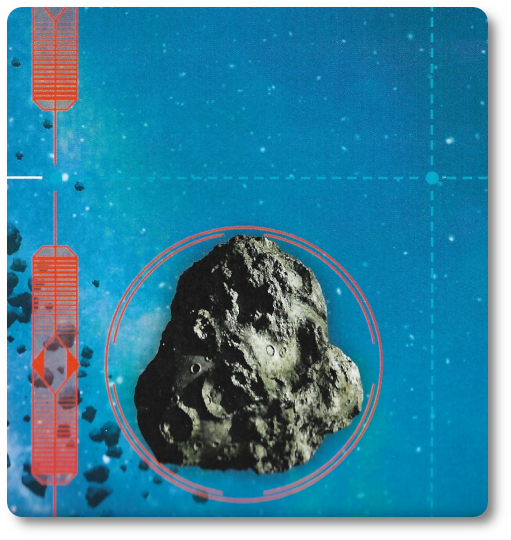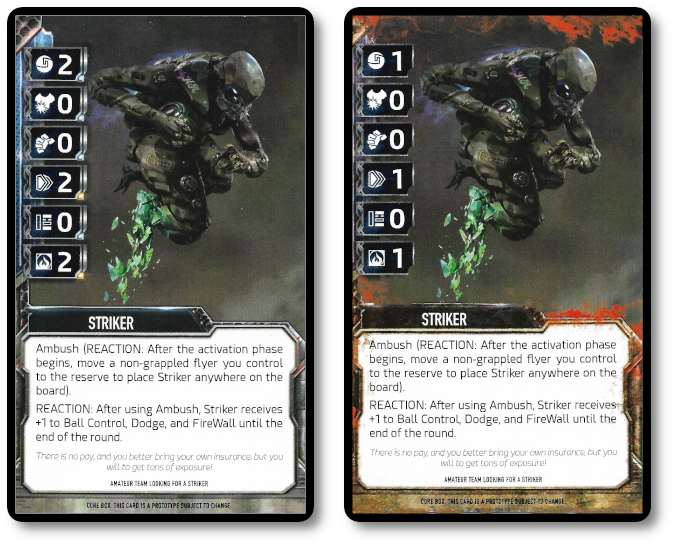Please Take Note: This is a review of the final game, but it might change slightly based on the success of the Kickstarter campaign. The game is being reviewed on the components and the rules provided with the understanding that “what you see is not what you might get” when the game is published. If you like what you read and want to learn more, we encourage you to visit the game’s website or Kickstarter campaign. Now that we have all that disclaimer junk out of the way, on with the review.

The Basics:
- For ages 10 and up (publisher suggests 14+)
- For 2 to 4 players
- Approximately 90 minutes to complete
Geek Skills:
- Active Listening & Communication
- Counting & Math
- Logical & Critical Decision Making
- Reading
- Strategy & Tactics
- Risk vs. Reward
- Visuospatial Skills
- Cooperative & Team Play
- Hand/Resource Management
- Worker Placement & Area Control
Learning Curve:
- Child – Moderate
- Adult – Easy
Theme & Narrative:
- In space, no one can hear you cheer on your team
Endorsements:
- Gamer Geek approved!
- Parent Geek mixed!
- Child Geek mixed!
Overview
German inventor, game developer, and engineer, Ralph Baer, said “People love video games because they do things they obviously can’t do in real life. That’s especially true with sports games because fans love to step into the shoes of their favorite athletes.” So very true. In this game, players get to step into the shoes of highly trained athletes who play a competitive game that is a mix of football and rugby. The arena is also a battle ground, where every movement is done in zero gravity and momentum could push you to victory or off the edge, spinning into space.
CoreBall: The Zero Gravity Sport, designed by Helio de Grado, Carlos G. Q., Mauricio Gomez and to be published by Burning Games, will reportedly be comprised of one Floating game board, six Circuit tiles, three SpaceSharks miniatures (Xerion, Phaser, Therinth), three BullBugs miniatures (Grasshopper, Wally, King), 12 Mercenaries (two copies of each: Forward, Safety, Striker, Hacker, Tackle, and Center), 18 Flyer cards (for all miniatures), two Sets of player cards (32 cards), a reasonable number of tokens, and four Victory Point dials. As this is a review of a prepublished game, I cannot comment on the game component quality. The “Floating” game board sits slightly above the gaming table, allowing the Circuit tiles to slide underneath it. The provided artwork by the talented Aleksandra Bilic, Zabi Hassan, Anthony Jones, and Fragan Tanguy gives the players a visual look a the game’s thematic gritty high-tech world in which the game’s narrative is set.
Note: Our review copy also included the Technotics Team and Preachers Team miniatures, as well as a few other bits and bobs that will be released as part of the Kickstarter second pledge level, Veteran Flyer. These extra components will also be released in stores simultaneously.
Welcome to the Game
To set up the game, first place the game board in the middle of the playing area.
Second , select the “Asteroid Field” Circuit sheets and place the “Flank” circuit sheet without obstacles underneath the game board. At this time, shuffle the remaining sheets and place face-down next to the game board. This pile is referred to as the “sheet bank”.
Third, give to each player and Victory Point dial and set the value to five.
Fourth, determine which of the players will be the first “ball controller”. Give to this player the First Player token which is placed in front of them. Give to each player a Ball token, as well, with the total number being provided being one less than the total number of players.
Fifth, have each player select a faction in player order. Once a player selects a faction, they collect all the miniatures and associated cards (all of which will be the same color). Each player should shuffle their deck of cards and place them face-down in front of them at this time. In addition, each player will also collect flyer cards and miniatures of each of the six Merc flyer miniatures.
Sixth, collect the tokens and make small piles (referred to as “pools”) for each token type. This area is referred to as the “token bank”.
Seventh, place the miniatures on the game board starting with the second player and continuing in player order, placing one miniature at a time in any square of the game board. Several rules apply when placing the miniatures. For example, there cannot be more than one miniature on the player’s own team in the same square when placing another miniature. After placing the miniatures, find and place the matching flyer card in the player’s area in the vertical “Ready” state. Place any remaining miniatures and cards to the player’s reserve.
Eighth, discard the current Circuit sheet (which is only used for game setup) and draw a new one, placing it under the game board.
That’s it for game setup. Start the first round of the match, skipping the Substitution phase for the first round only.
Playing in Zero G’s
CoreBall is played in turns, rounds, and matches. There are four rounds per match and each round is comprised of three phases, wherein players take turns. Each phase is summarized here.
The Substitution Phase
This phase is skipped during the first round of the game, but is completed in all subsequent rounds.
During this phase, bring in additional miniatures (referred to as “flyers” in the game) if the minimum number of miniatures needed to be in play is not met. The number of miniatures is based on the number of players. Miniatures are brought in first from the player’s reserve. If none are left in the player’s reserve, they bring in any other miniature they still have access to.
Players take turns bringing in their miniatures during this phase in player turn order sequence. Miniatures are placed on the borders of the game board. If there are any obstacles that would cause damage or inflict a penalty, the player will resolve it once the miniature is in play. That is the only placement rule, setting aside the setup miniature rules.
The Activation Phase
During this phase, players take turns taking actions with their available miniatures. If a player does not have a miniature to activate on their turn, they are skipped. When a miniature is used, its corresponding card is rotated 90 degrees sideways. The player can then take up to two Movement actions and one other action in any order they see fit. After resolving the actions, the player removes one Tired token and one Hacked token from their activated card. The actions are as follows:
Movement
Each Movement action allows the player’s miniature to leave its current square and enter any orthogonally adjacent square. If any obstacles are in the miniature’s path, the player resolves them as required. A player cannot move their miniature into a square if doing so would mean there were more than four miniatures occupying it and only two miniatures from a team, at most, can occupy the same square. In addition, any miniature card with a Hacked token cannot take the Movement action on their turn. Remember to remove this token after resolving the miniatures actions.
Miniatures can be pushed off, directed to move off, or the player can volunteer to move their miniature off the game board. By doing so, the player places the miniature in their reserve and removes all tokens on the associated card. Loss of victory points might also be suffered, which is recorded on the Victory Point dial. If the miniature leaves the board holding the Ball token, the Ball token is dropped in the exit square and can now be taken up by any other player.
Actions
Actions can be performed before, during, or after moving. Most of the time, a player will only be able to take one action per miniature, but in-game conditions might allow for more. Actions include picking up the ball, stealing the ball, passing the ball, pushing other miniatures, grappling other miniatures, escaping, and hacking an opponent’s miniature (thematically speaking, they are hacking the opponent’s suit causing them to glitch out).
During the game, a player’s miniature could become “tired”. If they are, the player can still move their miniature, but they cannot take any additional actions. It takes very little effort to move in zero gravity.
To perform the selected action, the player’s currently activated miniature must have a value higher than zero on the associated skill or have a stated ability describing the action to be resolved, meeting all the noted requirements.

- Ball skill
- Push skill
- Grapple skill
- Dodge skill
- Hacking skill
- Firewall skill
- Name of miniature
- Abilities
The action to be taken is announced and then resolved. The player’s opponent’s must counter if possible with supporting miniatures possibly countering in a support role. Counters include dodging and taking other defense actions. Counters are considered a free action, but miniature must have a value higher than zero on the associated skill or have a stated ability describing the action to be resolved, meeting all the noted requirements, just like a normal action.
Countering creates a confrontation. To resolve a confrontation, all players involved draw a card from their deck and place it face-up for all to view. This card’s value is added to the associated skill in play to create a combined new value referred to as the “confrontation value”. The player with the miniature with the highest confrontation value wins the confrontation, resolving the skill as required, resulting in success or failure of the initial action. If the active player loses, they may elect to keep the card for later use with the noted ability. Otherwise, all cards used are discarded.

This phase continues until all miniatures who can (and the player wants to) take their actions.
The Resolution Phase
During this phase, a number of effects are resolved. Each are summarized here and are completed in sequential order.
Step One: Momentum Resolution
As the miniatures move across the game board, they might pick up additional speed which creates uncontrolled momentum. This is tracked with Momentum tokens which are now resolved. Miniatures are moved a set number of squares depending on the Momentum tokens collected. This could force miniatures off the game board or into dangerous territory, so watch out!
Step Two: Area Terrain Resolution
The terrain of the game board interferes with the miniatures ability to properly take actions. The obstacles are printed on the Circuit sheets or as tokens. For example, the following image shows two different terrain obstacles. The first is the asteroid that has a red circle. During the Resolution phase, any miniature occupying the same space suffers one point of damage. The second is the red bar next to the asteroid. This is a force field, which inflicts damage on any miniature that moved through it. Additional obstacles include railguns, kinetic barriers, and an assortment of debris.

As the game progresses, a player’s miniature can suffer damage. This makes the miniature “wounded”. Wounded miniatures use the wounded side of their associated card, which displays a reduced value in skills and abilities. Wounded miniatures are never healed, meaning they remain wounded for the duration of the game even if they leave the game board. If a wounded miniature suffers another point of damage, they are eliminated from the game.

Miniature at full health on the left and wounded on the right – note the skill value changes
Step Three: Score Balls
For each miniature a player owns that is currently in control of a Ball token, they receive three victory points.
Step Four: Clean Up
Any obstacle tokens currently in play are now removed and placed back in their associated pools.
Step Five: Circuit Change
The current Circuit sheet is discarded and a new one is placed. Miniatures are not moved.
Step Six: Player Order Change
The First Player token is now given to the next player in turn order sequence.
Step Seven: Return to Ready
All associated cards with miniatures in play are returned to their ready state.
The round is now over. A new round now begins unless the game has ended.
Victory and Defeat
The game ends after the fourth and final round. The player with the most victory points recorded on their Victory Point dial wins the game.
Game Variants
The game setup described above is meant to get the players quickly into the game without burdening the game setup time with a lot of additional thinking. If the players are well versed with the rules, game setup could include select a specific circuit sheet to use and players can build their own teams.
To learn more about CoreBall: The Zero Gravity Sport, visit the game’s website or Kickstarter campaign.
Final Word
 CoreBall was the most popular with our oldest Child Geeks, game play wise, but caught the attention of every Child Geek who sat down to play a game or two. The game is a lot of fun to look at and draws the eyes quickly into its depths. The game play, while not overly difficult to teach, can be rather intense and players must calculate a lot of movement and actions before they take their turn. While this proved to be a real bonus for our elitist players, for those casual and younger players, CoreBall was just a bit too heavy and long to keep them interested. As one Child Geek put it, “I like the game, but want it to take less time.” This was easily fixed by making the game only two rounds long, but this didn’t change some of our Child Geek’s feelings. For those Child Geeks who did enjoy the game, they couldn’t stop praising it. According to one such Child Geek, “I wish this was a real sport. I like how you can hack into another player’s suit and freeze them out or push them off the board, hurtling through space!” When all the votes were in, the Child Geeks gave CoreBall a mixed review, demonstrating this game was only of real interest to the older and more experienced players.
CoreBall was the most popular with our oldest Child Geeks, game play wise, but caught the attention of every Child Geek who sat down to play a game or two. The game is a lot of fun to look at and draws the eyes quickly into its depths. The game play, while not overly difficult to teach, can be rather intense and players must calculate a lot of movement and actions before they take their turn. While this proved to be a real bonus for our elitist players, for those casual and younger players, CoreBall was just a bit too heavy and long to keep them interested. As one Child Geek put it, “I like the game, but want it to take less time.” This was easily fixed by making the game only two rounds long, but this didn’t change some of our Child Geek’s feelings. For those Child Geeks who did enjoy the game, they couldn’t stop praising it. According to one such Child Geek, “I wish this was a real sport. I like how you can hack into another player’s suit and freeze them out or push them off the board, hurtling through space!” When all the votes were in, the Child Geeks gave CoreBall a mixed review, demonstrating this game was only of real interest to the older and more experienced players.
 The Parent Geeks liked the game’s idea and game play, but like the Child Geeks, found the game to be a bit too long. According to one Parent Geek, “I liked the game, which is funny because I don’t like sports much, but the game itself just felt a bit long. I wanted it to take about 45 or 30 minutes at most. That feels like a good amount of time at the table.” Like the Child Geeks, the Parent Geeks did not agree. For those Parent Geek players who enjoyed longer games with more tactical and strategic game play, CoreBall was a great success. As one Parent Geek put it, “A really fun and interesting new take on sports games that mixed science fiction with good old-fashioned tossing of the ball. I liked it all, but especially liked how fast the game felt without it feeling rushed or mismanaged.” When all the votes were in, the Parent Geeks gave CoreBall a mixed review, with the clear line dividing the two being between the casual players and those who liked a deeper game.
The Parent Geeks liked the game’s idea and game play, but like the Child Geeks, found the game to be a bit too long. According to one Parent Geek, “I liked the game, which is funny because I don’t like sports much, but the game itself just felt a bit long. I wanted it to take about 45 or 30 minutes at most. That feels like a good amount of time at the table.” Like the Child Geeks, the Parent Geeks did not agree. For those Parent Geek players who enjoyed longer games with more tactical and strategic game play, CoreBall was a great success. As one Parent Geek put it, “A really fun and interesting new take on sports games that mixed science fiction with good old-fashioned tossing of the ball. I liked it all, but especially liked how fast the game felt without it feeling rushed or mismanaged.” When all the votes were in, the Parent Geeks gave CoreBall a mixed review, with the clear line dividing the two being between the casual players and those who liked a deeper game.
 The Gamer Geeks were all in. According to one Gamer Geek, “A good mix of tactical movement, strategic game play, and simple rules that allows for a lot of fun and memorable game play moments. I liked how the teams are pre-built but you can also build your own, I liked how combat was resolved – most of the time – and it is clear the game designers wanted the game to be about thinking things through and then quickly resolving the action to get to the next action. I enjoyed it and would play it again.” Another Gamer Geek said, “Surprisingly light on the rules, but deep in game play. The ever-changing field you play on was a neat addition and the sometimes brutal game play was a real joy. It’s a winner in my book. Good stuff.” When all the votes were in, the Gamer Geeks voted to fully approve and endorse CoreBall.
The Gamer Geeks were all in. According to one Gamer Geek, “A good mix of tactical movement, strategic game play, and simple rules that allows for a lot of fun and memorable game play moments. I liked how the teams are pre-built but you can also build your own, I liked how combat was resolved – most of the time – and it is clear the game designers wanted the game to be about thinking things through and then quickly resolving the action to get to the next action. I enjoyed it and would play it again.” Another Gamer Geek said, “Surprisingly light on the rules, but deep in game play. The ever-changing field you play on was a neat addition and the sometimes brutal game play was a real joy. It’s a winner in my book. Good stuff.” When all the votes were in, the Gamer Geeks voted to fully approve and endorse CoreBall.
 CoreBall, despite being over an hour-long is most cases, feels like a very fast game. There are not that many miniatures on the board and actions are quickly resolved. What takes time in the game is thinking your move through. Because everything in the game is essentially floating and moving around, you have to take into account momentum and how a single push in one direction could have additional effects going forward. This challenges players to think not only of the impact of their move but also how the impact impacts future moves. A creative exercise in critical and forward thinking.
CoreBall, despite being over an hour-long is most cases, feels like a very fast game. There are not that many miniatures on the board and actions are quickly resolved. What takes time in the game is thinking your move through. Because everything in the game is essentially floating and moving around, you have to take into account momentum and how a single push in one direction could have additional effects going forward. This challenges players to think not only of the impact of their move but also how the impact impacts future moves. A creative exercise in critical and forward thinking.
My first favorite aspect of the game was the ever-shifting game board. I really liked what the designers did here. The same old stadium with the same old defined boundaries won’t be found in this game! Each round introduces a new playing field and new challenges. No miniatures are ever moved, which makes the shifting of the ground on which players battle a quick exercise with no impact to miniature locations. A smart way to keep the game fresh without disrupting the players’ ability to tactically move in strategic ways.
My second most favorite aspect of the game is also one of the most boring. I like how the confrontations were resolved with a simple flip of the card. No dice, but the results are still the same due to the cards being random. But since cards are limited, the results are also limited in the number of times they appear. Better yet, the noted abilities on the cards act as an additional catalyst for future turns to be really interesting. Some of our players found the cards to be just a gimmicky randomizer, but I found their use in the game to be an excellent addition, adding more depth to the game with a reasonable level of chance mixed in.
It’s important to note that while the game did not get endorsed by all our players, that should not suggest the game wasn’t enjoyed by all our players. CoreBall didn’t get endorsements from those who found it to be too long or too involved, not because it lacked energy, engagement, or fun. This is a game that will demand your player’s time and attention, where a strategic and tactical mind is necessary to fully explore the game’s depths and be competitive. That can be taxing to players who enjoy a more casual game. Make no mistake, this might be a sports game, but it’s also a game about combat. You will dodge, and duck, and hit your way to victory. The game is not won in miles, but in inches and broken jaws.
Overall I am most pleased with the game. A new take on sports games that works and works well. Everything from the high-tech method of sabotaging your opponent through hacking to flat-out crashing into your opponent keeps the game interesting and engaging on multiple levels. I enjoyed it and so did most of our players. I think you will, too, if you already enjoy sports games and are looking to inject some aggressive game play. Do give CoreBall: The Zero Gravity Sport a try.
This is a paid for review of the game’s final prototype. Although our time and focus was financially compensated, our words are our own. We’d need at least 10 million dollars before we started saying what other people wanted. Such is the statuesque and legendary integrity of Father Geek which cannot be bought except by those who own their own private islands and small countries.



